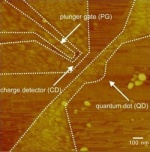 |
|
Carbon ElectronicsWe have been working with the nobel-prize winning material graphene - single layers of carbon atoms which exhibit electronic properties relevant to a wide range of device applications and fundamental questions in condensed matter physics.
|
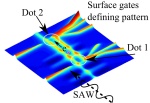 |
|
Surface Acoustic WavesA SAW pulse can be used to take an individual electron from one isolated quantum dot to another (from a dot at bottom right in the above figure, to one at top left), and then to send it back again. The process can be repeated without error up to 60 times. As described above, this may be useful for transferring quantum information between a quantum processor and its memory, or between parts of the same processor, using the electron's spin as a qubit. By dropping the electron into a region of holes, a single photon may be generated, either for readout of the electron's spin, or for use as a polarised photon, or even as a photon qubit.
|
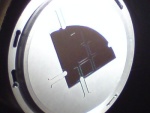 |
|
Molecular Beam EpitaxyThe Semiconductor Physics Group at the Cavendish has three main MBE chambers devoted to the growth of III-V compounds. Most of the work concentrates on the GaAs/AlGaAs/InGaAs material system but growth of Nitrides and novel materials is also being investigated.
|
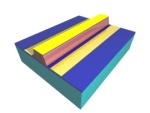 |
|
Terahertz ResearchThe group's research interests in THz Quantum Cascade Lasers (QCLs) focus on the design, growth, fabrication, and testing of high power THz QCLs emitting across a broad frequency range. All the THz QCL wafers are grown in-house via a state-of-the-art Molecular Beam Epitaxy (MBE) growth centre at the Cavendish Laboratory. The group enjoys strong industrial collabarations with Teraview UK, as well as close working relations with major QCL research groups across Europe.
|
 |
|
Quantum OpticsElectrons and holes confined withing a quantum dot (QD) present an interesting multi-level system (see figure 1) which can be used to investigate quantum phenomenon. Our work uses Stranski-Krastanov grown QDs, which are embedded within layed semiconductor structures grown via molecular beam epitaxy.
|
 |
|
2D TransportThe frictional drag experiment is a novel probe of the properties of bilayer systems. The concept is similar to conventional friction and is illustrated below. A current is driven in one layer (the drive layer), and interlayer electron-electron interactions transfer momentum to a nearby layer (the drag layer). The drag layer is conventionally in an open circuit configuration, where no drag current is allowed to flow.
|
 |
|
1D TransportThe electron is a fundamental building block of nature and is indivisible in isolation, yet we have performed an experiment that shows that electrons in narrow wires can appear to split apart. The experiment was performed in the University of Cambridge's Cavendish Laboratory with the theoretical support coming from University of Birmingham physicists.
|
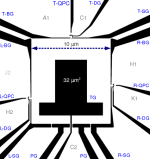 |
|
Quantum Dot RefrigerationThe two-dimensional electron gas in GaAs/AlGaAs heterostructures has diverse applications at cryogenic temperatures, but is elevated to higher temperatures than the ambient lattice temperature because of reduced phonon coupling. Therefore, a mechanism which can efficiently cool the electron gas to below the lattice temperature can have a far reaching impact on the performance of heterostructure devices, and can provide a window to new physics by making lower temperature regimes accessible.
|
 |
|
Fundamentals of Low Dimensional SystemsAn introduction to the physics of low dimensional systems, their behaviour in magnetic fields and more....
|
